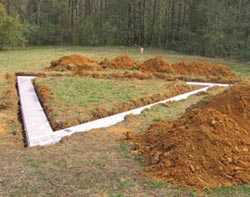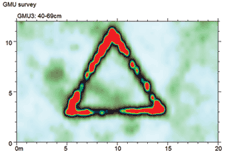Behind the Scenes
Embedded sculptures ‘rediscovered’ as digital art images

Using a diagram of the original footprint of the colony’s fort, Brown installed the Jamestown Triangle as a public art project at George Mason University in Fairfax, Va.
Art professor R.G. Brown confounds traditional concepts of art by creating sculptures—only to bury them underground. Using ground penetrating radar and electromagnetic conductivity to survey the buried forms, Brown then challenges the viewer to rediscover them indirectly, as reflected digital images.
This marriage of art and science embraces technology in conjuring a range of images in various colors and forms. “The idea is that the piece really exists in a parallel way, not as we see it first-hand but as the instruments interpret it,” says Brown. “We can’t see air, gravity or microwaves, but we know they exist—and the powerful influences they exert on our lives.”
Brown, who is also trained as a landscape architect, took courses in remote sensing in graduate school. He discovered that Ervan Garrison, a geologist who heads UGA’s department of anthropology, was using non-invasive ground-penetrating radar to find and survey historic sites and locate buried objects. The two have since collaborated on several public art installations in Georgia, Virginia, and Florida.
“This is a true collaboration in that the same technique [ground-penetrating radar] can be used in reverse to help archeologists interpret what they find in unknown sites,” says Brown.
For more information, contact R.G. Brown at: rgbrown@uga.edu
 |

